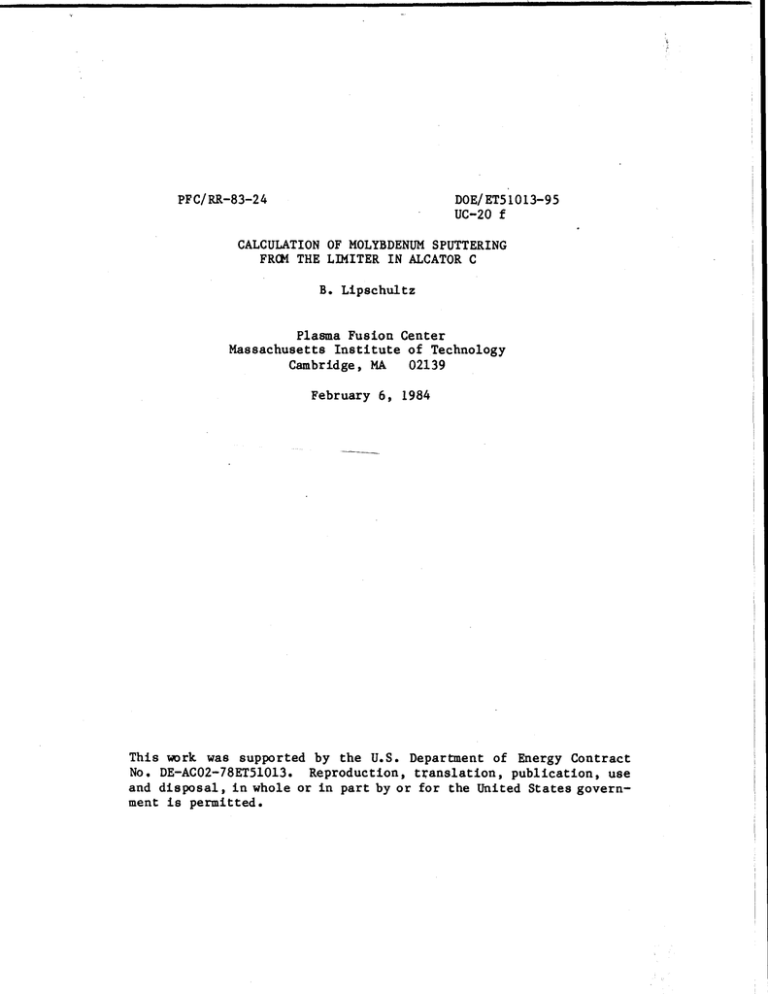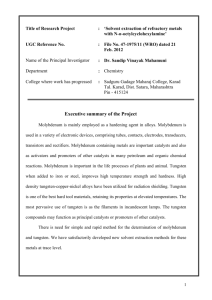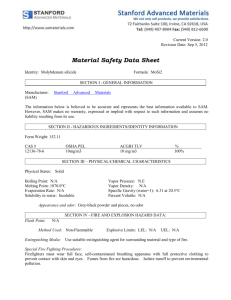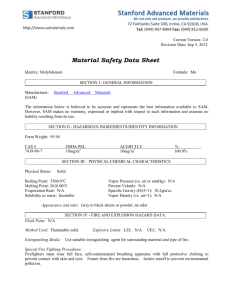PFC/RR-83-24 by Department of Energy Contract DOE/ET51013-95
advertisement

PFC/RR-83-24 DOE/ET51013-95 UC-20 f CALCULATION OF MOLYBDENUM SPUTTERING FRCM THE LIMITER IN ALCATOR C B. Lipschultz Plasma Fusion Center Massachusetts Institute of Technology Cambridge, MA 02139 February 6, 1984 This work was supported by the U.S. Department of Energy Contract No. DE-AC02-78ET51013. Reproduction, translation, publication, use and disposal, in whole or in part by or for the United States government is permitted. CALCULATION OF MOLYBDENUM SPUTTERING FROM THE LIMITER IN ALCATOR C Abstract A simple one-dimensional model for sputtering from the surface of a molybdenum limiter has been developed. this model are due that follows. to thermal Sources of sputtering included in ions and the subsequent self-sputtering The resultant molybdenum source rates match those calcu- lated based on molybdenum line emission data from the main plasma coupled with an anomalous impurity diffusion coefficient. A review of the source rate dependence on plasma parameters is also included. - 1 - Introduction Impurity radiation can have strong effects on tokamak plasmas, ticulary high-Z power losses impurities, from which radiate such processes from can cause the plasma par- core. the temperature The profile to become centrally hollow and the plasma current to be disrupted. For the forseeable future high-Z materials will be utilized for internal hardware in tokamaks. It therefore behooves us to minimize the density of these impurities in the plasma core through reduction of the impurity confinement time in the main plasma and/or reduction of the impurity source rate at the plasma edge. The former is studied through the use of the laser- blowoff impurity injection technique [1]. by either reducing the source reducing its generation at the material subsequent transport use of a divertor). generation process The latter goal can be reached surface into the main plasma (by, or by for example, The focus of this paper is the study of the impurity at a material surface. The particular impurity in volved in this study is molybdenum. Molybdenum has been the limiter surface material in contact with the plasma for a majority of Alcator C discharges. Thorough characterizations of the effects of molybdenum impurities on the main plasma have appeared elsewhere [2-5]. The principal measurements of molybdenum radiation emission have been obtained from a 16-detector bolometer array and a flatcrystal grazing incidence from these Illustrative instruments are shown in figures relative brightness shown in figure 1. vs. ne, spectrometer. of Mo emission at 77A, 1 and as a plots of results 2 respectively. function of The Re, is Measurements of molybdenum density in the main plasma as measured by the bolometer array, are shown in figure 2. Quite - 2 - rapid increases in molybdenum density ne is lowered. Although these measurements with a molybdenum limiter, in the main plasma were are found as obtained in discharges the impurity behavior in graphite-limited in plasmas is qualitatively similar. Impurity source ficient in (Figure modelling conjunction 1), indicates with the strongly with decreasing employing the [5]. of II. help us design question arises that diffusion intrinsic also The limiters of molybdenum physical process that creates this source? it may anomalous observations source e an impurities increases -- coef- what quite is the If this question is answered, reduce the impurity sources. Possible Source Processes There are two mechanisms from a surface [6]: by which high-Z impurities can be removed evaporation and physical sputtering. Lower Z mater- ials can be removed through these and other processes as well. of molybdenum is the number possible review of of more impurity attractive removal source Evaporation involves than, processes generation a local for are example, fewer. mechanisms, heating of the carbon For see The study a because thorough McCracken surface. This [6]. could occur through thermal plasma flow to the limiter or through more exotic processes such as unipolar arcs and runaway electrons which create local 'hot' spots. Physical sputtering involves a momentum transfer process. An inci- dent particle imparts energy E > Ebinding to a surface atom in a direction out of the surface. The incident particle must be of proper mass as well - 3 - as energy to efficiently transfer momentum. Typically, the sputtering coefficients peak at mi = m2 where the subscript refers to incident and sputtered particles. Physical sputtering obviously involves multiple collisions since the incident and sputtered particles travel in opposite directions. As a consequence of the dependencies detailed above, the sputtering coefficient can be described as follows [71: C = S(E) Z. - 1.8)l.5 75 (Z2 - 1.8)2 EB (1) (E - Eth) Z )2 (E - Eth + 50 ZO. 7 5 C EB = 2000 for incident hydrogen = 400 for all other particles = binding energy of material Eth = threshold energy for sputtering (4M1 +M22 = EB ( (2) 4M1 M2 Further characterization of the source behavior would be useful for determining whether evaporation or physical sputtering is the dominant process. The dependence limiter installed this paper. of the in the tokamak source rate on ne, was discussed The He dependence is qualitatively limiter but the magnitude with a molybdenum in the introduction to similar with a graphite of the rate is much reduced. This indicates - 4 - that the primary for molybdenum source It limiter discharges. is also is during these discharges limiter is the primary More important, the impurity for true that molybdenum is vacuum vessel walls removed, the limiter molybdenum plated on the so that when the molybenum site becomes components. other vessel to appears generation process remain the same due to similarities in the ne dependences. As the mass of the background gas is increased, background gas mass. does the molybdenum source rate. tering is is the source depends, Another parameter upon which the molybdenum so This seems to imply that physical sput- the dominant process but other possibilities need to be dis- cussed. Experimental measurements indicate the source rate is constant on the discharge time arcs which to tend cause in fact, The only evaporation process measurements show that i time dependent molybdenum are seen in the experiment 'bursts', portional to runaway electron and This disqualifies scale. [8] left the power (see Figure is thermal Such injections. loading. Thermocouple increases roughly pro- to the limiter 3). influxes. 'natural' as unipolar This would produce a source rate Charge-exchange neu- dependence opposite to that which is observed. Physical sputtering remains to be discussed. trals from the main plasma or charged ions flowing through the edge will cause surface sputtering. Charge exchange flux (E increases as the plasma density is lowered [9]. dence is what we not. seek, > 1 keV) to the wall Although this ie depen- the source dependence on background gas mass is As stated above, the molybdenum source rate increases with the mass of the background gas. But the flux of charge exchange neutrals out of a - 5 - helium plasma is much lower than for a hydrogenic plasma. Physical sputtering, due to the flow of ions in the edge, does match the mass dependence we seek . The decrease in thermal flux to the limiter with with decreasing He has been discussed. The Fe dependence of the ion sputtering, due to this thermal plasma, has the opposite trend: to the limiter is approximately equal to nedge nedge x Cs ' The flux nedge / Tedge- I Tedge is a constant function of R e, then the flux (rthermal c nedge1/2 _ We must multiply this flux by a sputtering (ne)1/2. coef- ficient, S(T), to obtain the total sputtered flux (rsputtered) rsputtered As can be than T1/, seen from rthermal x S(T) = Figure 4, S(T) has a much stronger dependence above a threshold energy. eTedge edge x e sputtered Tedge e ~~ This is the density (temperature) dependence we have been searching given that Langmuir probe measurements for, show Tedge rises as He decreases [10]. Plasma Sheath Models Electrons are Examining a the wall much more field line in the much faster charged with respect than mobile edge, ions. to the wall. than ions electrons These by the factor / mi/me. are found to be lost to field lines become positively The resulting potential, confined to - 6 - several debye lengths in distance from the wall, adjusts itself until the ion and electron plasma sheath. currents Only reach the wall. to the electrons with energy f ne f vxge(vx)dvx 1/2 This mvy2 > is called the esheath will currents are equal at a point along the field line then = a) vs vxgi(vx)dvx (2) 0 To obtain ge,i(vx), the electron (ion) vx distribution function, integrate the corresponding Rewriting (2) are equal. If the ion and electron very far away from the wall (x ne wall general distribution function over vy & Vz* after this integration, -Mev2/2kT l/2 f we must v e and assuming Te = Ti = T, -miv2/2kT 1 dv Mil/2 I we find v e dv VS Solving for vs and, therefore, 4 sheath) kT elsheath (3) X - = mi ln 2 For H 2 this value is - me (4) 3.8 kT. More importantly, the average energy carried by electrons in the x direction can be determined f <Wxe> 1 -- my vs 2 = -fmv2/2kT y e dv K -Mv22kT f = 2 vxe vs es + kT (5) dvx - 7 - ==> = <We> (6) e4s + 2kT The similar calculation for ions yields <Wi> (7) e4s + 4 kT = <Wi> + <We> = <WTOT> => 2 kT = The above calculations give the energy carried by ions and electrons up to the sheath. In transferred from electrons the through traveling The to ions. sheath, total heat the energy eps is to the wall, flow QTOT, is: QTOT = r <WTOT> nV = - <WTOT> 4 kT = (8) x (eqs + 4kT) ' n Of primary interest is the ion energy and flux to the wall: <Wi>wall = e*s + 2kT rion = n (9) kT The purpose standing of nored: of this the plasma (10) exercise sheath. has been to Many processes, give a physical however, under- have been ig- Energy losses (gains) or physical mechanisms that could preferen- tially drive particles (e.g. rf) along the length of the field line. - 8 - Recycling near the increases in e . wall, or other particle sources, can cause There can be reflection of particles and/or electron emission at the wall. The wall itself has which must enter into the calculation. some local secondary work function All of these processes should be included. Further physical insight into the sheath can be obtained by examining the solution to Poissons equation at the sheath [11]. for the velocity (u(x)) One can solve within the sheath using energy and momentum con- servation: e4x)+1 21 e$(x) + - 2 miu2(x) = - 2 (1 (11) miuo 2 n(x)u(x) = nou0 (12) 2e (x) ==> ni(x) = ) no (1 - -1/2 (13) M u The subscript o refers to values of those variables at the sheath edge. Substituting (13) into Poisson's equation, one finds that there are solutions only if the ion velocity at the sheath edge, the sound speed. is greater than This is called the Bohm Sheath Criterion. tion is that there is some long range electric ions and uo, decelerates potential is 1/2 mv, electrons. ~ kT/2. integral treatment above. The field which accelerates magnitude This treatment The implica- of this 'presheath' ignores no less than the There are a host of more rigorous calculations to be found in the literature. For a thorough listing see reference [12]. - 9 - The form for ion flux and energy through the sheath, developed by Emmert [12], has been used for this exercise. Essentially, model is a fully kinetic treatment through the sheath. are allowed outside the sheath. the Emmert Particle sources The flux and energy per ion hitting the wall are: kT = r (14) - 2 IrMi = <Wi> For the case e(Osheath - 2ukT + e(Osheath of Te Owall) Ti, = = - and 2.5kT. The Owall) Z = (15) 1, we values find for r and different from those of the simpler calculations the factor a as function he being finds due (half to space the = difference maxwellian <Wi> above. between @ x = cc), 2.2, p = are 1.2 and certainly Emmert explains the and distribution a full-space maxwellian. Numerical Model The computer code developed for this application is one-dimensional along a minor radius in the scrape-off layer. Langmuir probe measurements of density and temperature in the plasma edge are used as input [10]. An analytic form [13] is fitted to this data for ease of evaluating the flux and energy of ions to the limiter. A numerical subroutine DSPUT [7] is used to finish the calculation by evaluating the sputtering coefficient. The analytic forms ne(r) ne (r = a) exp -(r - a)/Xn used for the density and temperature profiles are = (16) - 10 - Te(r) Te (r = a) exp -(r - a)/XT = (17) so that four parameters specify both profiles. are shown in Figures 5 and 6. gas . A complete set of not available. Plots of these parameters The probe measurements are for D2 working (ne(r), Te(r)) measurements for all plasma He is Interpolation and extrapolation of the data is performed when needed utilizing limiter thermocouple measurements of thermal loading as a check. (Figure 3). Results The results of this calculation are given by line (b) This should be compared with line (a), from observations of intrinsic in Figure the impurity source as determined impurities (figure 1) , in conjunction with an empirically derived anomalous impurity diffusion model [5]. lines (a) and (b) are determined from D2 discharges utilizing a radius molybdenum limiter. 7. The uncertainty limits Both 16.5 cm shown for the points of line (b) reflect the range in experimental values shown in Figures 3, 5 and 6. There is a possible factor of 2 uncertainty in line (a) due to possible variations in source location. The conclusion is that these calculations are not in agreement. The obvious physical process that might account for this disagreement is self-sputtering. The molybdenum ionized and returns to the limiter. sputtered by the D2 thermal ions is These ions, because of their mass and charge, can have rather large sputtering coefficients (see Figure 4). To properly include self-sputtering, a two-dimensional impurity transport model for the edge would have to be developed. beyond the scope of this study. Such a calculation is - 11 A crude model for the sputtered molybdenum been implemented. Fifteen percent of the sputtered molybdenum is assumed to enter the plasma with molybdenum that enters The molybdenum that state which is a 85% remaining in the edge. the plasma returns remains function in the edge plasma of Tedge. ionized molybdenum. molybdenum returns This The final result to Furthermore, to the edge with charge the the <q/e> = 6. is ionized to a charge Tedge is evaluated using the data of reference 14. of this behavior has therefore state dependence In limiter on steady state, all and sputters more of this repetitive process is an infinite series; ~ rthermal x (1 + j (Seff)i) sput i1- = rthermal / (1 - Seff) sput (18) sput where rsput is the total number of fthermal sput self sputtering. thermal ions. Seff = is sputtered molybdenum atoms the sputtered molybdenum including flux due to The effective sputtering coefficent, Seff, is described by .15 reflecting the x S(Tedge, Z contributions molybdenum atoms ionized in = 6) + .85 of the x sputtering main and (19) S(Tedge, Zedge) coefficients edge plasmas determined by respectively. Inclusion of self-sputtering in the numerical model yields line (c) in Figure 6. ulation (line models. This result is much closer to the impurity transport calca). In fact, The difference lies within the uncertainties of the if the ions were allowed to be hotter than the elec- trons, the results would most likely match. - 12 - Conclusions A very simple one dimensional model of sputtering has been developed. Results agree with separate calculations of the molybdenum source rate based only on the molybdenum density in the main plasma and an anomalous impurity diffusion This coefficient. edge sputtering model was not applied to constituent gasses other than D2 due to lack of probe measurements which are used as input. However, the scaling with the mass of the background gas agrees with central plasma measurements. The question still remains: a molybdenum limiter One present? processes are involved: What is the molybdenum source without possible explanation is that two physical sputtering by charge exchange neutrals to provide a background level and self sputtering as well. simple to calculate the charge exchange It is fairly flux spectrum of neutrals from the main plasma using the FRANTIC code [15]. The subroutine DSPUT can then be used to evaluate the sputtered flux assuming 10% of the wall is covered with molybdenum. Line (d) in Figure 7 indicates the result. Self sputtering by molydenum is not included in this calculation. uncertainty range represents neutral density dependence the on ne. variability of specifying Further experimental the The edge work would be quite useful in understanding this question. Acknowledgements The author thanks J. Brooks of Argonne National Lab for the use of DSPUT and C. Fiore of M.I.T. for help with FRANTIC. Discussions with J. Rice, J. Terry, B. LaBombard, S. Wolfe, and M. Pickrell were informative and encouraging. - 13 Figure Captions Figure 1: Brightness at 77A (M0 2 5 +) as a function of line average electron density, ne at constant current, with a 10 cm molybdenum limiter. Figure 2: Central molybdenum density determined from bolometer measurements of radiated power profiles. Figure 3: Energy deposited on a 16.5 cm molybdenum limiter during a discharge vs. nie. Values of power loading are calculated assuming energy is deposited over a fixed shot length. Figure 4: Sputtering coefficient for; deuterium ions incident on (----); and molybdenum ions incident on molybdenum molybdenum Figure 5: Parameters describing the density profile vs. ie; neo, 'n* Figure 6: Parameters describing the temperatures profile vs. Fe; Teo, XT- Figure 7: Calculated molybdenum influx as a function of Re* Line (a) is from impurity transport modeling employing the data of Figure 1. Line (b) is the prediction assuming molybdenum is sputtered by thermal ions only. Line (c) is the results shown by line (b) but with molybdenum self sputtering included. Line (d) is the source due to neutral sputtering of molybdenum from a wall 10% covered by molybdenum. - 14 - References [1] E. S. Marmar, J. E. Rice, J. L. Terry, & F. H. Seguin, Nuclear Fusion, 22, 1567 (1982). [2] R. R. Parker, M. M. Pickrell, B. Lipschultz, Bull. Amer. Phys. Soc., 27, 937 (1982). [31 M. M. Pickrell, "The Role of Radiation on the Power Balance of the Alcator C Tokamak" M.I.T. Plasma Fusion Center Report PFC/RR-82-30. [4] J. E. Rice, E. S. Marmar, K. J. Pinto, "Application of the Emperical Anomalous Impurity Diffusion Model to Interpret Observations of Molybdenum and Chlorine Radiation From Alcator C", Bull. Amer. Phys. Soc., 27, 937 (1982) [5] J. E. Rice, E. S. Marmar, B. Lipschultz, J. L. Terry, Submitted to Nuclear Fusion. [6] G. M. McCracken, B. E. Stott, Nucl. Fusion, 19, 889 (1979). [7] D. L. Smith, J. N. Brooks, D. E. Post, D. B. Heifetz, Proceedings of the 9th Sympsium of Engineering Problems of Fusion Research, Oct. 1981, Chicago, USA. [81 B. Lipschultz, et al., Bull. [9] C. L. Fiore, Private communication. [10] B. LaBombard, B. Lipschultz, M. M. Pickrell, Y. Takase, Bull. Amer. Phys. Soc., 27, 1037 (1982). [111 F. F. Chen, Introduction to Plasma Physics, Plerion Press, New York, (1974) p. 245-6. [12] G. A. Emmert, et al., Phys. of Fluids, 23, 803 (1980). [13] K. Uehara, et al., Plasma Physics, 21, 89 (1979) [141 TFR Group, Plasma Physics 19, 587(1977) [151 H. H. Towner, R. J. Goldston, D. C. McCune, and S. Tamor, Bull. Amer. Phys. Soc., 26, 857 (1981). Amer. Phys. Soc., 26, 975 (1981). 77 4 BRIGHTNESS (arb. scale) oNt r O .- X 3 (71 I I FIGURE 1 I 2 12 100 51 100 0 ~ zel 5IUR 0 4c I I .0 0 140 0. * 0 .0 400 * S 120 0 0 0 S 0 6 S Og 300 100 *0g a 0 0 0 *0 * * S 80 * 0e * w5 * * 0 0 S 0 #0 * 200 0 OgO 60 * ** 0 0 0 0 0 0 0 0 0* S S Seg S @0 0 40 20F 100 @0 S *3430 gO 0 * * 0 *SS S 0 1.0 I I 2.0 3.0 4.0 5.0 He (1014cni3 FIGURE 3 '.1/f 10 1 II T II I I I IIi I .II , , , - 1- , I It 10 0 U) 0 1 L) I 162 0. / I I I ch (0 / I / -3 104 10 I I I I I 10 I I I I I 10 101 - ---- - -I - - - -I - - -I I - - 10 3 102 105 Energy (eV) FIGURE 4 $17' 12.0 .3 10.0 8.0 E 6.0 C E 4.0 Xn x.2!. 1.0 2.0 ie 2.0 -eo S0.0 3,.0 (1014 cm 3 ) FIGURE 5 6Y67 I F I~ .35 T I 30.0 E U I20.0 0 I- XT4 -Teo .25, I .u I 2.0 Re 110.0 3.0 (101 4 cni 3 ) FIGURE 6 jy4i r I 10 0 Ej 101 N T A 0 -I C F 0N B I I 1.0 2.0 6e 3.0 FIGURE 7 (1014cm~3) 0446




